Modeling of Organic Solar Cells for Sustainable Energy Solutions
VerifiedAdded on 2023/01/10
|16
|3475
|39
Project
AI Summary
This project proposal focuses on modeling organic solar cells to address future energy demands and promote sustainability. The research aims to design a solar cell model that reduces costs, weight, and enhances performance. The introduction highlights the limitations of traditional energy sources and the growing need for renewable alternatives like solar power. The literature review covers existing research on organic photovoltaic technology, including basic organic photovoltaic technology and heterojunction photovoltaic technology. The research question explores how to model solar cells to meet future energy demands, and the objectives include reducing costs, weight, and increasing performance. The methodology emphasizes fabricating thicker films for maximum absorption and controlling the transportation of electrons/holes to enhance efficiency. The project is significant as it offers a roadmap for meeting future energy demands through sustainable energy solutions.

Modeling Of Organic Solar Cells For Future Applications 1
MODELING OF ORGANIC SOLAR CELLS FOR FUTURE APPLICATIONS
By Name
Course
Instructor
Institution
Location
Date
MODELING OF ORGANIC SOLAR CELLS FOR FUTURE APPLICATIONS
By Name
Course
Instructor
Institution
Location
Date
Paraphrase This Document
Need a fresh take? Get an instant paraphrase of this document with our AI Paraphraser
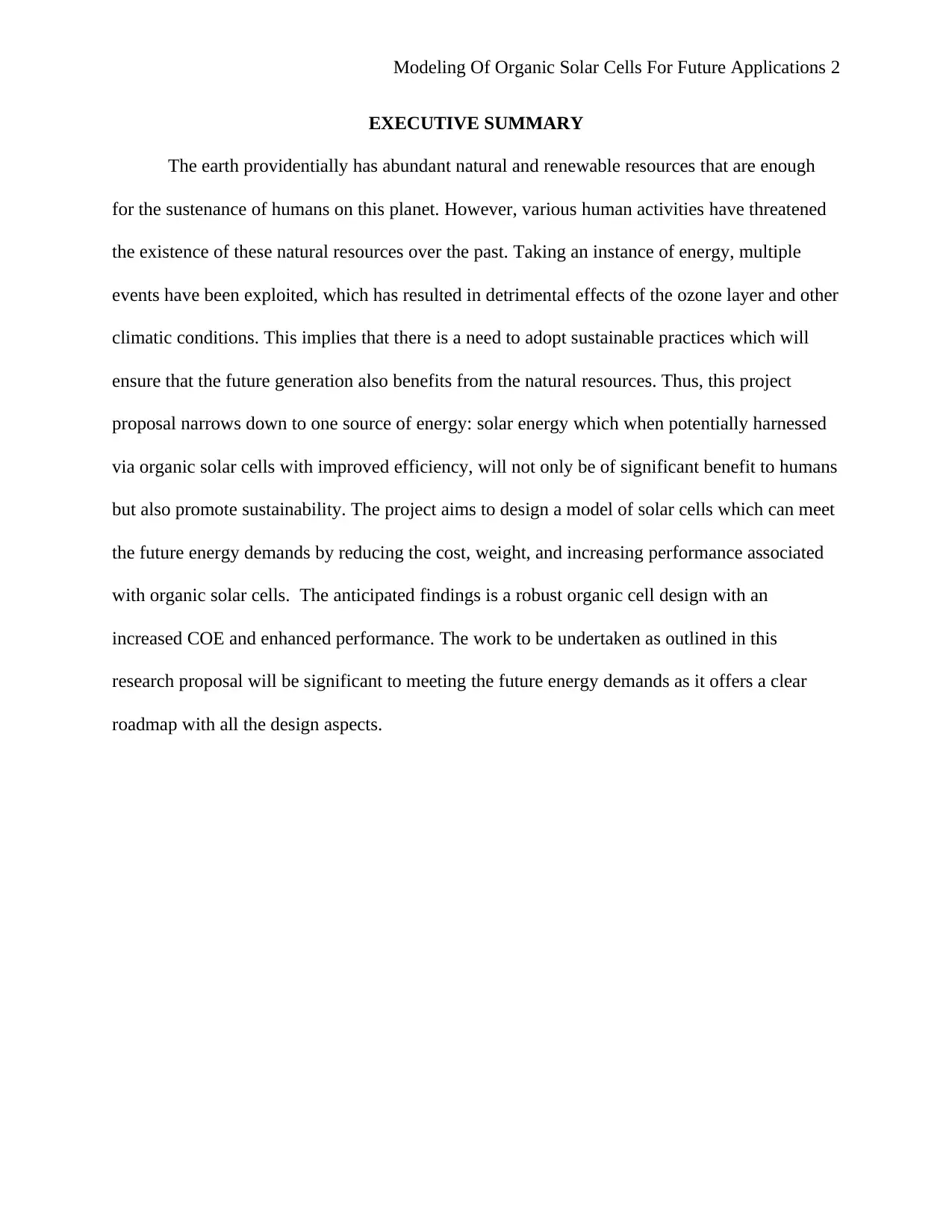
Modeling Of Organic Solar Cells For Future Applications 2
EXECUTIVE SUMMARY
The earth providentially has abundant natural and renewable resources that are enough
for the sustenance of humans on this planet. However, various human activities have threatened
the existence of these natural resources over the past. Taking an instance of energy, multiple
events have been exploited, which has resulted in detrimental effects of the ozone layer and other
climatic conditions. This implies that there is a need to adopt sustainable practices which will
ensure that the future generation also benefits from the natural resources. Thus, this project
proposal narrows down to one source of energy: solar energy which when potentially harnessed
via organic solar cells with improved efficiency, will not only be of significant benefit to humans
but also promote sustainability. The project aims to design a model of solar cells which can meet
the future energy demands by reducing the cost, weight, and increasing performance associated
with organic solar cells. The anticipated findings is a robust organic cell design with an
increased COE and enhanced performance. The work to be undertaken as outlined in this
research proposal will be significant to meeting the future energy demands as it offers a clear
roadmap with all the design aspects.
EXECUTIVE SUMMARY
The earth providentially has abundant natural and renewable resources that are enough
for the sustenance of humans on this planet. However, various human activities have threatened
the existence of these natural resources over the past. Taking an instance of energy, multiple
events have been exploited, which has resulted in detrimental effects of the ozone layer and other
climatic conditions. This implies that there is a need to adopt sustainable practices which will
ensure that the future generation also benefits from the natural resources. Thus, this project
proposal narrows down to one source of energy: solar energy which when potentially harnessed
via organic solar cells with improved efficiency, will not only be of significant benefit to humans
but also promote sustainability. The project aims to design a model of solar cells which can meet
the future energy demands by reducing the cost, weight, and increasing performance associated
with organic solar cells. The anticipated findings is a robust organic cell design with an
increased COE and enhanced performance. The work to be undertaken as outlined in this
research proposal will be significant to meeting the future energy demands as it offers a clear
roadmap with all the design aspects.

Modeling Of Organic Solar Cells For Future Applications 3
INTRODUCTION
A significant percentage of electricity that is currently utilized on the globe emanates
from sources such as natural gas, coal, oil as well as traditional sources of energy which has
recently been faced with sustainability issues. These sources have as well faced other challenges
concerning security, rising prices, as well as the risks associated with climate change and
environmental issues. As a result, various agencies have come out in support of other renewable
sources of energy which are have minimal disadvantages. The renewable resources generally are
unlimited in availability; however, this is not the case with fossil fuels, as they tend to get
depleted.
One of the most rapidly growing technologies is solar power generation (Brabec et al.,
2011). As at now, the rate of consumption in the world by statistic is averagely 13 terawatts.
With the increase of living standards and the increasing number of populations, this number is
expected to rise to 30 terawatts. When this anticipated power is made available through the
burning of the fossil fuels, then the levels of carbon in the atmosphere will surely go up, resulting
into global warming and associated climate and environmental issues which may not be
desirable. Hence, a challenge that is facing a majority of the engineers as at now is to come up
with a technology which will be able to meet the demands of 30 terawatts without causing too
much harm into the atmosphere.
From the existing knowledge and principles, it is possible to generate this amount of
power by the utilization of fossil fuels in expanding nuclear plants. Contrarily, there is the need
to develop desirable renewables sources which come along with minimal harm to the
environment and humanity. McGhee notes that 120000 terawatts of radiation are deposited by
the sun on the earth’s surface, implying that there is a sufficient amount of power or instead
INTRODUCTION
A significant percentage of electricity that is currently utilized on the globe emanates
from sources such as natural gas, coal, oil as well as traditional sources of energy which has
recently been faced with sustainability issues. These sources have as well faced other challenges
concerning security, rising prices, as well as the risks associated with climate change and
environmental issues. As a result, various agencies have come out in support of other renewable
sources of energy which are have minimal disadvantages. The renewable resources generally are
unlimited in availability; however, this is not the case with fossil fuels, as they tend to get
depleted.
One of the most rapidly growing technologies is solar power generation (Brabec et al.,
2011). As at now, the rate of consumption in the world by statistic is averagely 13 terawatts.
With the increase of living standards and the increasing number of populations, this number is
expected to rise to 30 terawatts. When this anticipated power is made available through the
burning of the fossil fuels, then the levels of carbon in the atmosphere will surely go up, resulting
into global warming and associated climate and environmental issues which may not be
desirable. Hence, a challenge that is facing a majority of the engineers as at now is to come up
with a technology which will be able to meet the demands of 30 terawatts without causing too
much harm into the atmosphere.
From the existing knowledge and principles, it is possible to generate this amount of
power by the utilization of fossil fuels in expanding nuclear plants. Contrarily, there is the need
to develop desirable renewables sources which come along with minimal harm to the
environment and humanity. McGhee notes that 120000 terawatts of radiation are deposited by
the sun on the earth’s surface, implying that there is a sufficient amount of power or instead
⊘ This is a preview!⊘
Do you want full access?
Subscribe today to unlock all pages.

Trusted by 1+ million students worldwide
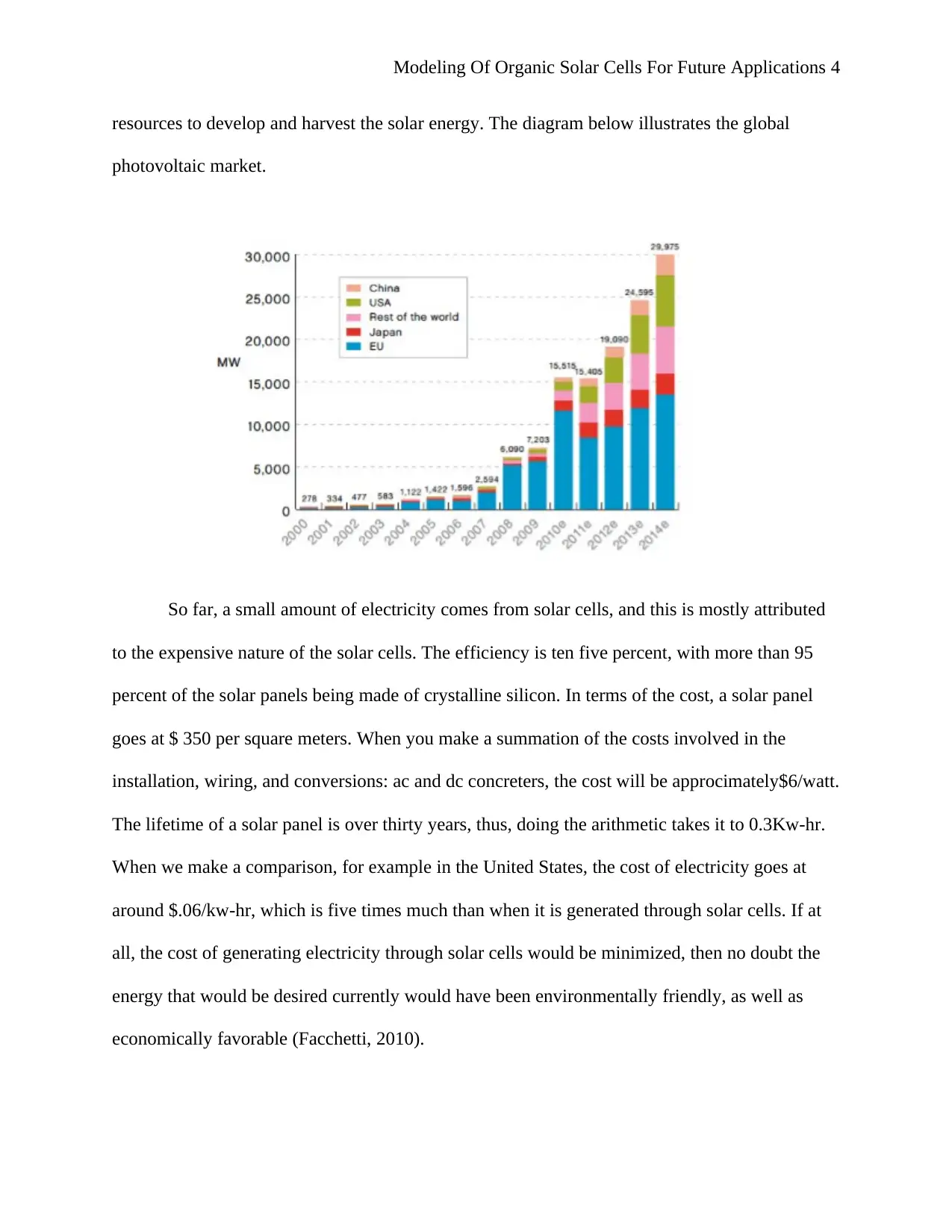
Modeling Of Organic Solar Cells For Future Applications 4
resources to develop and harvest the solar energy. The diagram below illustrates the global
photovoltaic market.
So far, a small amount of electricity comes from solar cells, and this is mostly attributed
to the expensive nature of the solar cells. The efficiency is ten five percent, with more than 95
percent of the solar panels being made of crystalline silicon. In terms of the cost, a solar panel
goes at $ 350 per square meters. When you make a summation of the costs involved in the
installation, wiring, and conversions: ac and dc concreters, the cost will be approcimately$6/watt.
The lifetime of a solar panel is over thirty years, thus, doing the arithmetic takes it to 0.3Kw-hr.
When we make a comparison, for example in the United States, the cost of electricity goes at
around $.06/kw-hr, which is five times much than when it is generated through solar cells. If at
all, the cost of generating electricity through solar cells would be minimized, then no doubt the
energy that would be desired currently would have been environmentally friendly, as well as
economically favorable (Facchetti, 2010).
resources to develop and harvest the solar energy. The diagram below illustrates the global
photovoltaic market.
So far, a small amount of electricity comes from solar cells, and this is mostly attributed
to the expensive nature of the solar cells. The efficiency is ten five percent, with more than 95
percent of the solar panels being made of crystalline silicon. In terms of the cost, a solar panel
goes at $ 350 per square meters. When you make a summation of the costs involved in the
installation, wiring, and conversions: ac and dc concreters, the cost will be approcimately$6/watt.
The lifetime of a solar panel is over thirty years, thus, doing the arithmetic takes it to 0.3Kw-hr.
When we make a comparison, for example in the United States, the cost of electricity goes at
around $.06/kw-hr, which is five times much than when it is generated through solar cells. If at
all, the cost of generating electricity through solar cells would be minimized, then no doubt the
energy that would be desired currently would have been environmentally friendly, as well as
economically favorable (Facchetti, 2010).
Paraphrase This Document
Need a fresh take? Get an instant paraphrase of this document with our AI Paraphraser
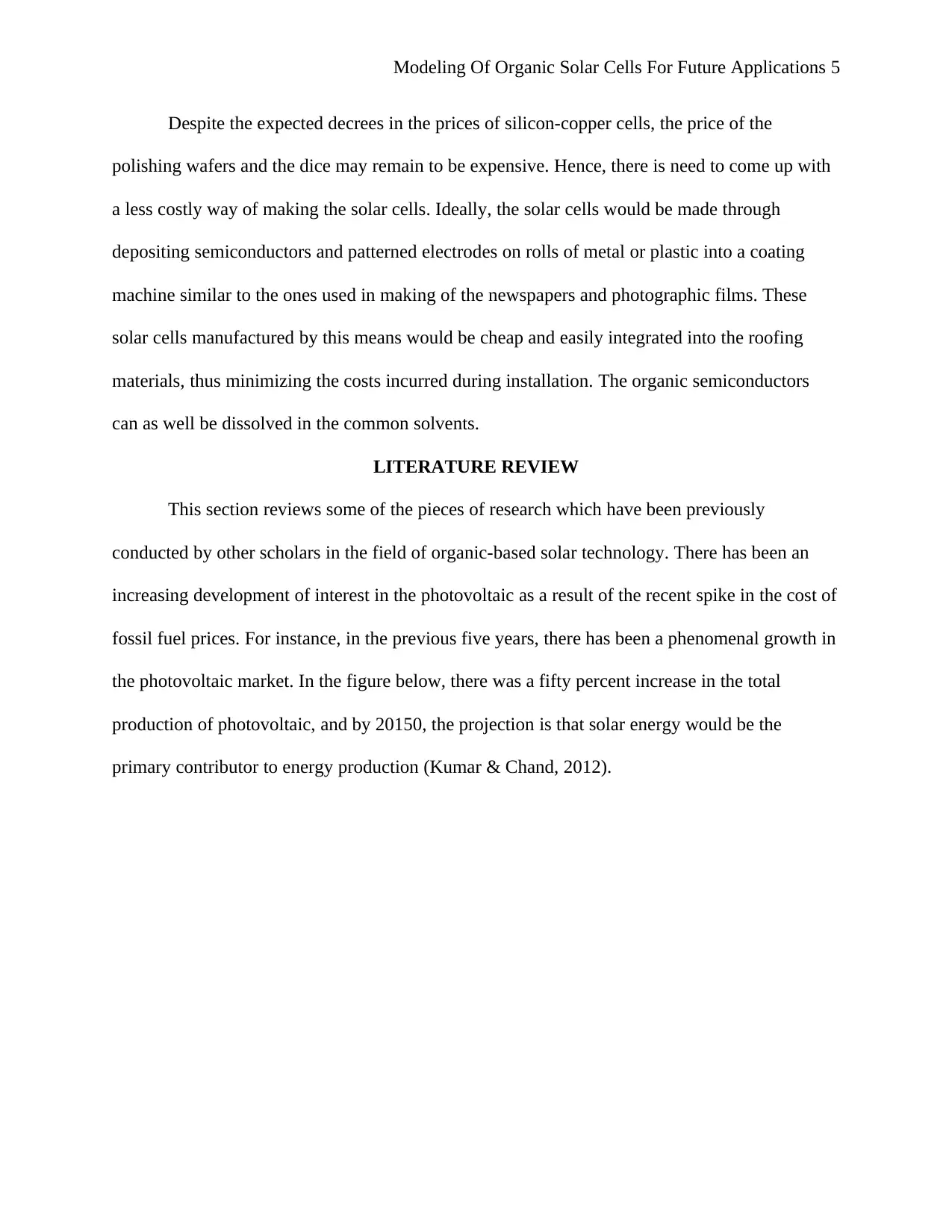
Modeling Of Organic Solar Cells For Future Applications 5
Despite the expected decrees in the prices of silicon-copper cells, the price of the
polishing wafers and the dice may remain to be expensive. Hence, there is need to come up with
a less costly way of making the solar cells. Ideally, the solar cells would be made through
depositing semiconductors and patterned electrodes on rolls of metal or plastic into a coating
machine similar to the ones used in making of the newspapers and photographic films. These
solar cells manufactured by this means would be cheap and easily integrated into the roofing
materials, thus minimizing the costs incurred during installation. The organic semiconductors
can as well be dissolved in the common solvents.
LITERATURE REVIEW
This section reviews some of the pieces of research which have been previously
conducted by other scholars in the field of organic-based solar technology. There has been an
increasing development of interest in the photovoltaic as a result of the recent spike in the cost of
fossil fuel prices. For instance, in the previous five years, there has been a phenomenal growth in
the photovoltaic market. In the figure below, there was a fifty percent increase in the total
production of photovoltaic, and by 20150, the projection is that solar energy would be the
primary contributor to energy production (Kumar & Chand, 2012).
Despite the expected decrees in the prices of silicon-copper cells, the price of the
polishing wafers and the dice may remain to be expensive. Hence, there is need to come up with
a less costly way of making the solar cells. Ideally, the solar cells would be made through
depositing semiconductors and patterned electrodes on rolls of metal or plastic into a coating
machine similar to the ones used in making of the newspapers and photographic films. These
solar cells manufactured by this means would be cheap and easily integrated into the roofing
materials, thus minimizing the costs incurred during installation. The organic semiconductors
can as well be dissolved in the common solvents.
LITERATURE REVIEW
This section reviews some of the pieces of research which have been previously
conducted by other scholars in the field of organic-based solar technology. There has been an
increasing development of interest in the photovoltaic as a result of the recent spike in the cost of
fossil fuel prices. For instance, in the previous five years, there has been a phenomenal growth in
the photovoltaic market. In the figure below, there was a fifty percent increase in the total
production of photovoltaic, and by 20150, the projection is that solar energy would be the
primary contributor to energy production (Kumar & Chand, 2012).

Modeling Of Organic Solar Cells For Future Applications 6
Basic Organic Photovoltaic Technology
As a result of the volume limitation of the semiconductor, the photovoltaic conversion
ratio has been limited to just a small section around the interfaces. This comes as a result of the
length of polymeric transfer of the organic semiconductors. Some of the first pioneers in the
fields of photovoltaic were the likes of Tang et al., who constructed a photovoltaic cell which
relied on organic thin film photo-detector. However, the associated efficiency was so low, being
just 1 percent. Later on, Banga and eta l. made some improvements on the photovoltaic cell
designed by tang and the colleagues and utilized copolymers. Subsequently, Wong eta l. used
materials such as metallopolymer/fullerene derivative blend as the photoactive material to
construct the solar cells and had an improved version with an efficiency of 4% (Liang et al.,
2010).
Also, Luque and his colleagues utilized quantum dots to increase efficiency by
incorporating the works of Gratzel et al.,. Which utilized g liquid–electrolyte–based dye-
Basic Organic Photovoltaic Technology
As a result of the volume limitation of the semiconductor, the photovoltaic conversion
ratio has been limited to just a small section around the interfaces. This comes as a result of the
length of polymeric transfer of the organic semiconductors. Some of the first pioneers in the
fields of photovoltaic were the likes of Tang et al., who constructed a photovoltaic cell which
relied on organic thin film photo-detector. However, the associated efficiency was so low, being
just 1 percent. Later on, Banga and eta l. made some improvements on the photovoltaic cell
designed by tang and the colleagues and utilized copolymers. Subsequently, Wong eta l. used
materials such as metallopolymer/fullerene derivative blend as the photoactive material to
construct the solar cells and had an improved version with an efficiency of 4% (Liang et al.,
2010).
Also, Luque and his colleagues utilized quantum dots to increase efficiency by
incorporating the works of Gratzel et al.,. Which utilized g liquid–electrolyte–based dye-
⊘ This is a preview!⊘
Do you want full access?
Subscribe today to unlock all pages.

Trusted by 1+ million students worldwide
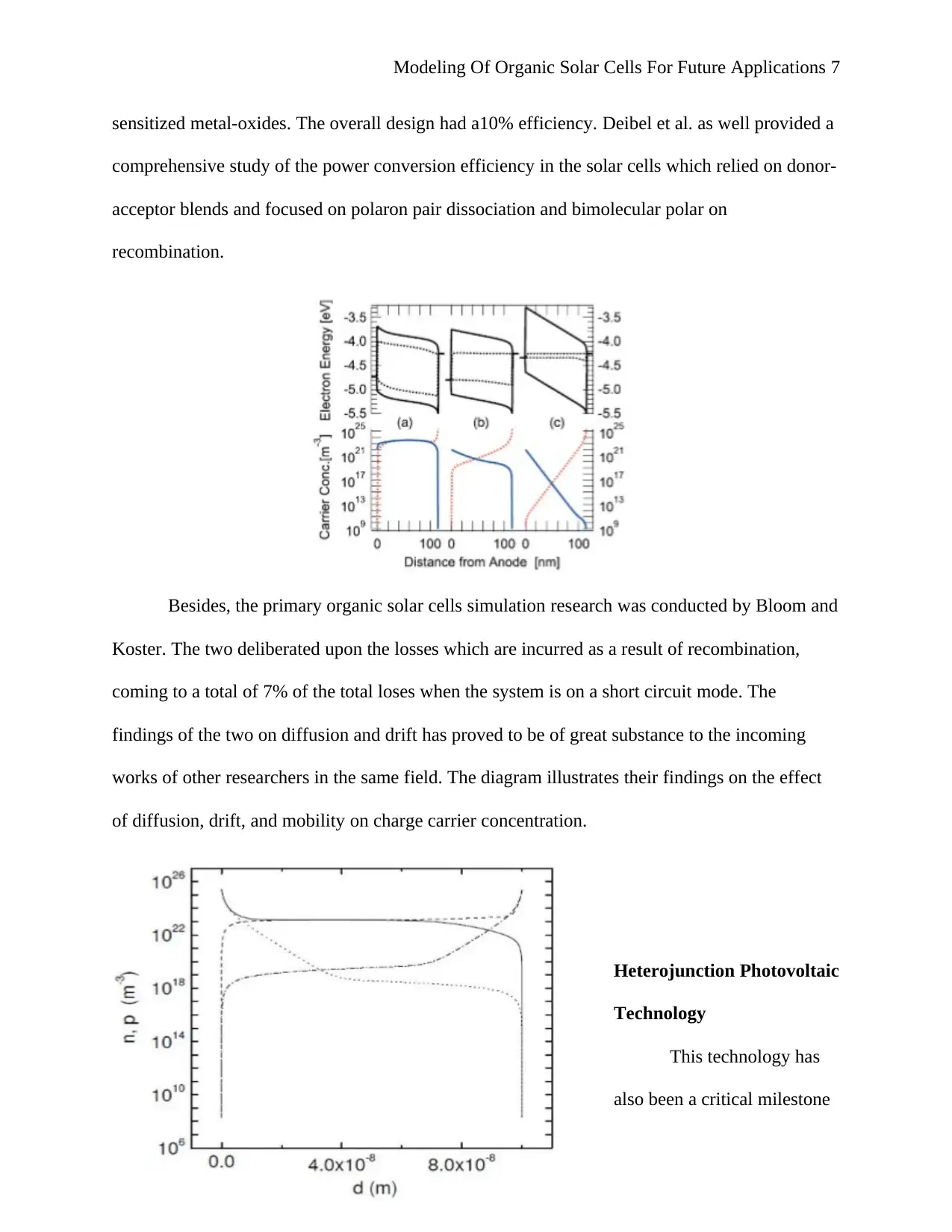
Modeling Of Organic Solar Cells For Future Applications 7
sensitized metal-oxides. The overall design had a10% efficiency. Deibel et al. as well provided a
comprehensive study of the power conversion efficiency in the solar cells which relied on donor-
acceptor blends and focused on polaron pair dissociation and bimolecular polar on
recombination.
Besides, the primary organic solar cells simulation research was conducted by Bloom and
Koster. The two deliberated upon the losses which are incurred as a result of recombination,
coming to a total of 7% of the total loses when the system is on a short circuit mode. The
findings of the two on diffusion and drift has proved to be of great substance to the incoming
works of other researchers in the same field. The diagram illustrates their findings on the effect
of diffusion, drift, and mobility on charge carrier concentration.
Heterojunction Photovoltaic
Technology
This technology has
also been a critical milestone
sensitized metal-oxides. The overall design had a10% efficiency. Deibel et al. as well provided a
comprehensive study of the power conversion efficiency in the solar cells which relied on donor-
acceptor blends and focused on polaron pair dissociation and bimolecular polar on
recombination.
Besides, the primary organic solar cells simulation research was conducted by Bloom and
Koster. The two deliberated upon the losses which are incurred as a result of recombination,
coming to a total of 7% of the total loses when the system is on a short circuit mode. The
findings of the two on diffusion and drift has proved to be of great substance to the incoming
works of other researchers in the same field. The diagram illustrates their findings on the effect
of diffusion, drift, and mobility on charge carrier concentration.
Heterojunction Photovoltaic
Technology
This technology has
also been a critical milestone
Paraphrase This Document
Need a fresh take? Get an instant paraphrase of this document with our AI Paraphraser
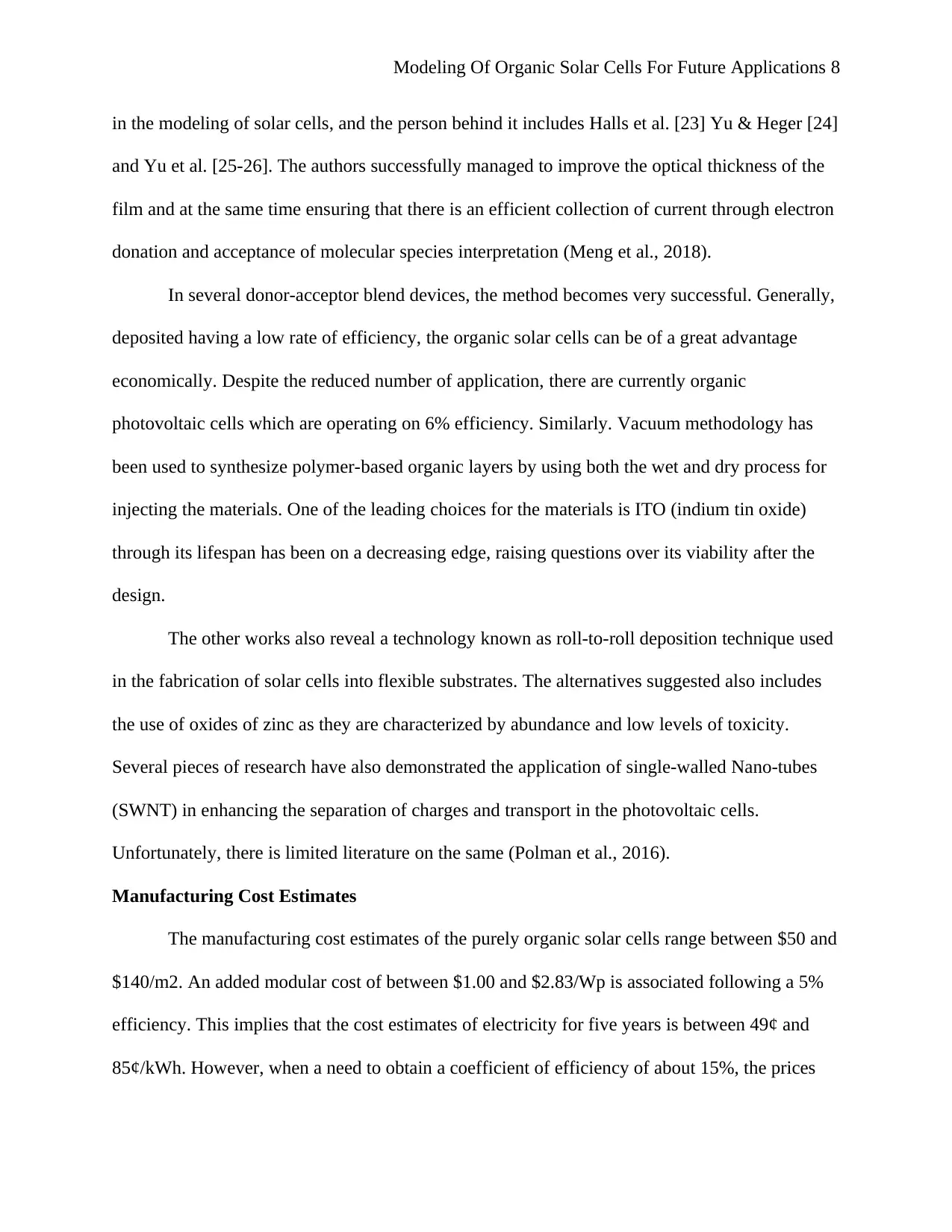
Modeling Of Organic Solar Cells For Future Applications 8
in the modeling of solar cells, and the person behind it includes Halls et al. [23] Yu & Heger [24]
and Yu et al. [25-26]. The authors successfully managed to improve the optical thickness of the
film and at the same time ensuring that there is an efficient collection of current through electron
donation and acceptance of molecular species interpretation (Meng et al., 2018).
In several donor-acceptor blend devices, the method becomes very successful. Generally,
deposited having a low rate of efficiency, the organic solar cells can be of a great advantage
economically. Despite the reduced number of application, there are currently organic
photovoltaic cells which are operating on 6% efficiency. Similarly. Vacuum methodology has
been used to synthesize polymer-based organic layers by using both the wet and dry process for
injecting the materials. One of the leading choices for the materials is ITO (indium tin oxide)
through its lifespan has been on a decreasing edge, raising questions over its viability after the
design.
The other works also reveal a technology known as roll-to-roll deposition technique used
in the fabrication of solar cells into flexible substrates. The alternatives suggested also includes
the use of oxides of zinc as they are characterized by abundance and low levels of toxicity.
Several pieces of research have also demonstrated the application of single-walled Nano-tubes
(SWNT) in enhancing the separation of charges and transport in the photovoltaic cells.
Unfortunately, there is limited literature on the same (Polman et al., 2016).
Manufacturing Cost Estimates
The manufacturing cost estimates of the purely organic solar cells range between $50 and
$140/m2. An added modular cost of between $1.00 and $2.83/Wp is associated following a 5%
efficiency. This implies that the cost estimates of electricity for five years is between 49¢ and
85¢/kWh. However, when a need to obtain a coefficient of efficiency of about 15%, the prices
in the modeling of solar cells, and the person behind it includes Halls et al. [23] Yu & Heger [24]
and Yu et al. [25-26]. The authors successfully managed to improve the optical thickness of the
film and at the same time ensuring that there is an efficient collection of current through electron
donation and acceptance of molecular species interpretation (Meng et al., 2018).
In several donor-acceptor blend devices, the method becomes very successful. Generally,
deposited having a low rate of efficiency, the organic solar cells can be of a great advantage
economically. Despite the reduced number of application, there are currently organic
photovoltaic cells which are operating on 6% efficiency. Similarly. Vacuum methodology has
been used to synthesize polymer-based organic layers by using both the wet and dry process for
injecting the materials. One of the leading choices for the materials is ITO (indium tin oxide)
through its lifespan has been on a decreasing edge, raising questions over its viability after the
design.
The other works also reveal a technology known as roll-to-roll deposition technique used
in the fabrication of solar cells into flexible substrates. The alternatives suggested also includes
the use of oxides of zinc as they are characterized by abundance and low levels of toxicity.
Several pieces of research have also demonstrated the application of single-walled Nano-tubes
(SWNT) in enhancing the separation of charges and transport in the photovoltaic cells.
Unfortunately, there is limited literature on the same (Polman et al., 2016).
Manufacturing Cost Estimates
The manufacturing cost estimates of the purely organic solar cells range between $50 and
$140/m2. An added modular cost of between $1.00 and $2.83/Wp is associated following a 5%
efficiency. This implies that the cost estimates of electricity for five years is between 49¢ and
85¢/kWh. However, when a need to obtain a coefficient of efficiency of about 15%, the prices
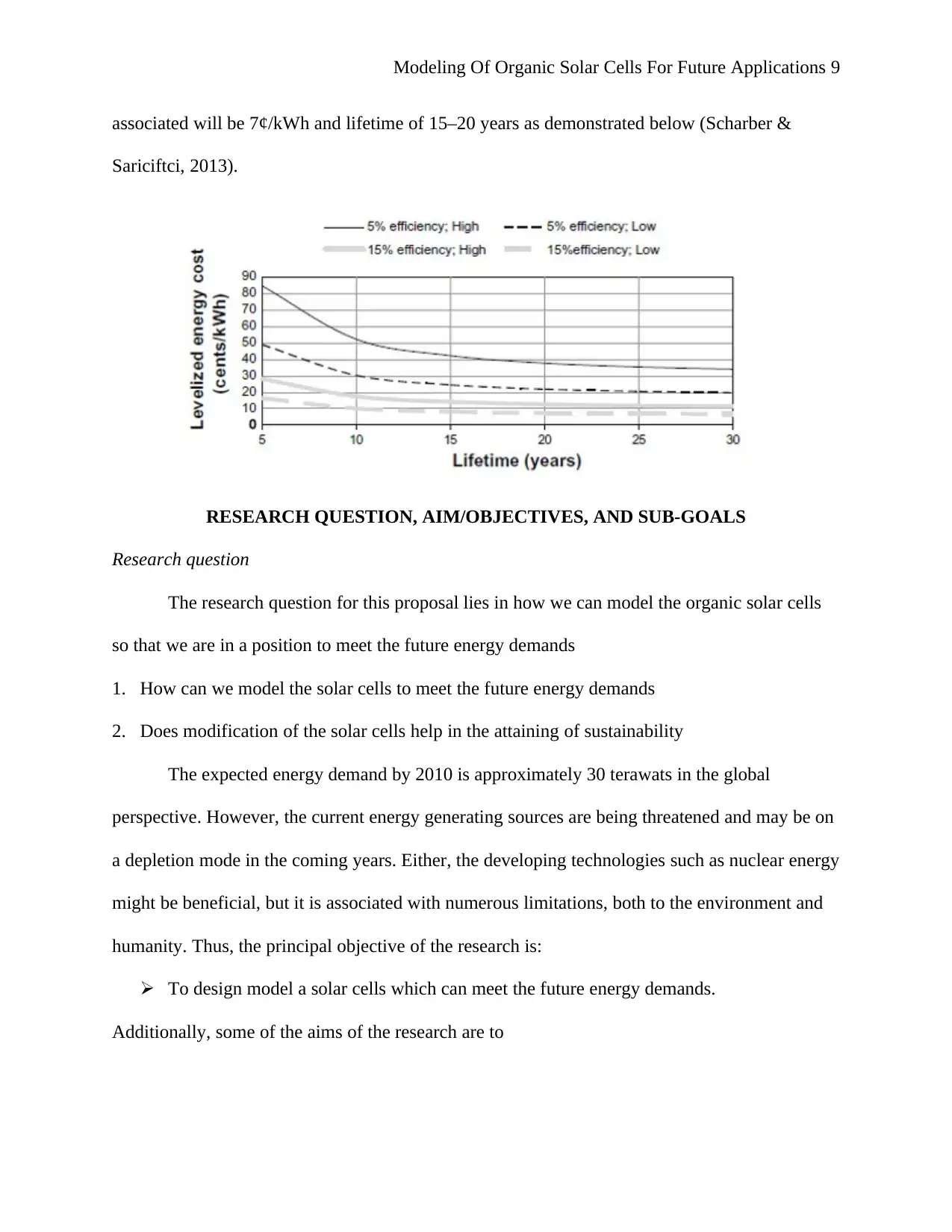
Modeling Of Organic Solar Cells For Future Applications 9
associated will be 7¢/kWh and lifetime of 15–20 years as demonstrated below (Scharber &
Sariciftci, 2013).
RESEARCH QUESTION, AIM/OBJECTIVES, AND SUB-GOALS
Research question
The research question for this proposal lies in how we can model the organic solar cells
so that we are in a position to meet the future energy demands
1. How can we model the solar cells to meet the future energy demands
2. Does modification of the solar cells help in the attaining of sustainability
The expected energy demand by 2010 is approximately 30 terawats in the global
perspective. However, the current energy generating sources are being threatened and may be on
a depletion mode in the coming years. Either, the developing technologies such as nuclear energy
might be beneficial, but it is associated with numerous limitations, both to the environment and
humanity. Thus, the principal objective of the research is:
To design model a solar cells which can meet the future energy demands.
Additionally, some of the aims of the research are to
associated will be 7¢/kWh and lifetime of 15–20 years as demonstrated below (Scharber &
Sariciftci, 2013).
RESEARCH QUESTION, AIM/OBJECTIVES, AND SUB-GOALS
Research question
The research question for this proposal lies in how we can model the organic solar cells
so that we are in a position to meet the future energy demands
1. How can we model the solar cells to meet the future energy demands
2. Does modification of the solar cells help in the attaining of sustainability
The expected energy demand by 2010 is approximately 30 terawats in the global
perspective. However, the current energy generating sources are being threatened and may be on
a depletion mode in the coming years. Either, the developing technologies such as nuclear energy
might be beneficial, but it is associated with numerous limitations, both to the environment and
humanity. Thus, the principal objective of the research is:
To design model a solar cells which can meet the future energy demands.
Additionally, some of the aims of the research are to
⊘ This is a preview!⊘
Do you want full access?
Subscribe today to unlock all pages.

Trusted by 1+ million students worldwide
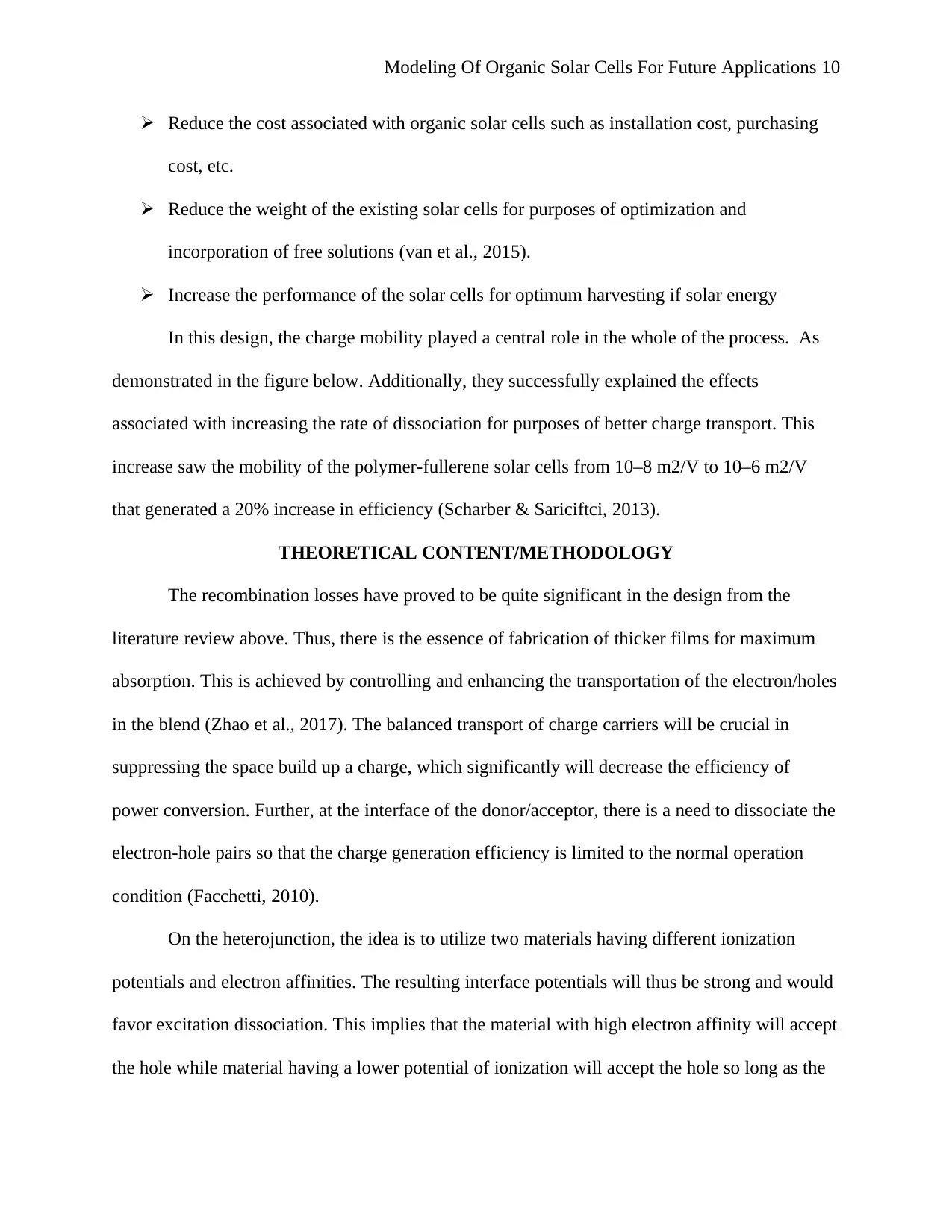
Modeling Of Organic Solar Cells For Future Applications 10
Reduce the cost associated with organic solar cells such as installation cost, purchasing
cost, etc.
Reduce the weight of the existing solar cells for purposes of optimization and
incorporation of free solutions (van et al., 2015).
Increase the performance of the solar cells for optimum harvesting if solar energy
In this design, the charge mobility played a central role in the whole of the process. As
demonstrated in the figure below. Additionally, they successfully explained the effects
associated with increasing the rate of dissociation for purposes of better charge transport. This
increase saw the mobility of the polymer-fullerene solar cells from 10–8 m2/V to 10–6 m2/V
that generated a 20% increase in efficiency (Scharber & Sariciftci, 2013).
THEORETICAL CONTENT/METHODOLOGY
The recombination losses have proved to be quite significant in the design from the
literature review above. Thus, there is the essence of fabrication of thicker films for maximum
absorption. This is achieved by controlling and enhancing the transportation of the electron/holes
in the blend (Zhao et al., 2017). The balanced transport of charge carriers will be crucial in
suppressing the space build up a charge, which significantly will decrease the efficiency of
power conversion. Further, at the interface of the donor/acceptor, there is a need to dissociate the
electron-hole pairs so that the charge generation efficiency is limited to the normal operation
condition (Facchetti, 2010).
On the heterojunction, the idea is to utilize two materials having different ionization
potentials and electron affinities. The resulting interface potentials will thus be strong and would
favor excitation dissociation. This implies that the material with high electron affinity will accept
the hole while material having a lower potential of ionization will accept the hole so long as the
Reduce the cost associated with organic solar cells such as installation cost, purchasing
cost, etc.
Reduce the weight of the existing solar cells for purposes of optimization and
incorporation of free solutions (van et al., 2015).
Increase the performance of the solar cells for optimum harvesting if solar energy
In this design, the charge mobility played a central role in the whole of the process. As
demonstrated in the figure below. Additionally, they successfully explained the effects
associated with increasing the rate of dissociation for purposes of better charge transport. This
increase saw the mobility of the polymer-fullerene solar cells from 10–8 m2/V to 10–6 m2/V
that generated a 20% increase in efficiency (Scharber & Sariciftci, 2013).
THEORETICAL CONTENT/METHODOLOGY
The recombination losses have proved to be quite significant in the design from the
literature review above. Thus, there is the essence of fabrication of thicker films for maximum
absorption. This is achieved by controlling and enhancing the transportation of the electron/holes
in the blend (Zhao et al., 2017). The balanced transport of charge carriers will be crucial in
suppressing the space build up a charge, which significantly will decrease the efficiency of
power conversion. Further, at the interface of the donor/acceptor, there is a need to dissociate the
electron-hole pairs so that the charge generation efficiency is limited to the normal operation
condition (Facchetti, 2010).
On the heterojunction, the idea is to utilize two materials having different ionization
potentials and electron affinities. The resulting interface potentials will thus be strong and would
favor excitation dissociation. This implies that the material with high electron affinity will accept
the hole while material having a lower potential of ionization will accept the hole so long as the
Paraphrase This Document
Need a fresh take? Get an instant paraphrase of this document with our AI Paraphraser
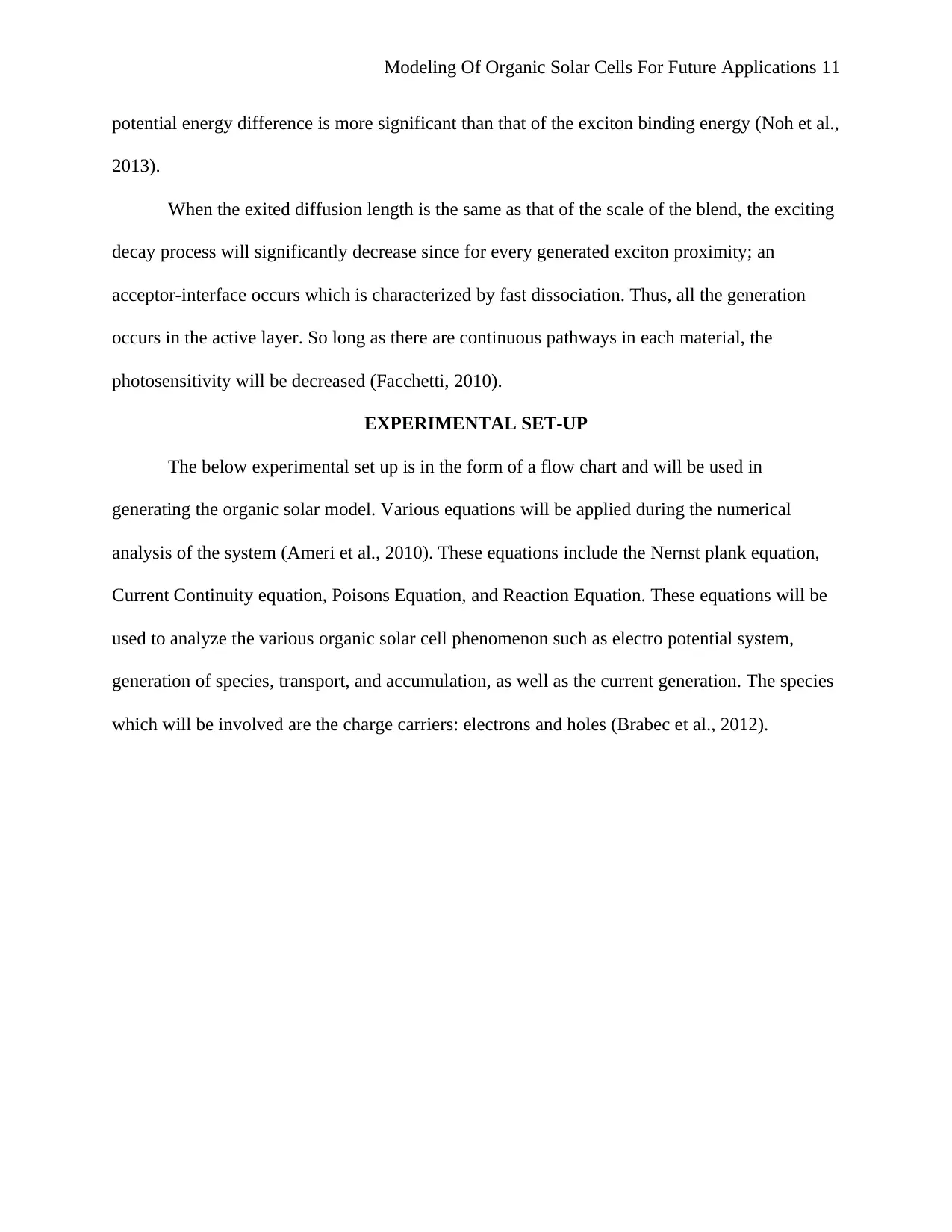
Modeling Of Organic Solar Cells For Future Applications 11
potential energy difference is more significant than that of the exciton binding energy (Noh et al.,
2013).
When the exited diffusion length is the same as that of the scale of the blend, the exciting
decay process will significantly decrease since for every generated exciton proximity; an
acceptor-interface occurs which is characterized by fast dissociation. Thus, all the generation
occurs in the active layer. So long as there are continuous pathways in each material, the
photosensitivity will be decreased (Facchetti, 2010).
EXPERIMENTAL SET-UP
The below experimental set up is in the form of a flow chart and will be used in
generating the organic solar model. Various equations will be applied during the numerical
analysis of the system (Ameri et al., 2010). These equations include the Nernst plank equation,
Current Continuity equation, Poisons Equation, and Reaction Equation. These equations will be
used to analyze the various organic solar cell phenomenon such as electro potential system,
generation of species, transport, and accumulation, as well as the current generation. The species
which will be involved are the charge carriers: electrons and holes (Brabec et al., 2012).
potential energy difference is more significant than that of the exciton binding energy (Noh et al.,
2013).
When the exited diffusion length is the same as that of the scale of the blend, the exciting
decay process will significantly decrease since for every generated exciton proximity; an
acceptor-interface occurs which is characterized by fast dissociation. Thus, all the generation
occurs in the active layer. So long as there are continuous pathways in each material, the
photosensitivity will be decreased (Facchetti, 2010).
EXPERIMENTAL SET-UP
The below experimental set up is in the form of a flow chart and will be used in
generating the organic solar model. Various equations will be applied during the numerical
analysis of the system (Ameri et al., 2010). These equations include the Nernst plank equation,
Current Continuity equation, Poisons Equation, and Reaction Equation. These equations will be
used to analyze the various organic solar cell phenomenon such as electro potential system,
generation of species, transport, and accumulation, as well as the current generation. The species
which will be involved are the charge carriers: electrons and holes (Brabec et al., 2012).
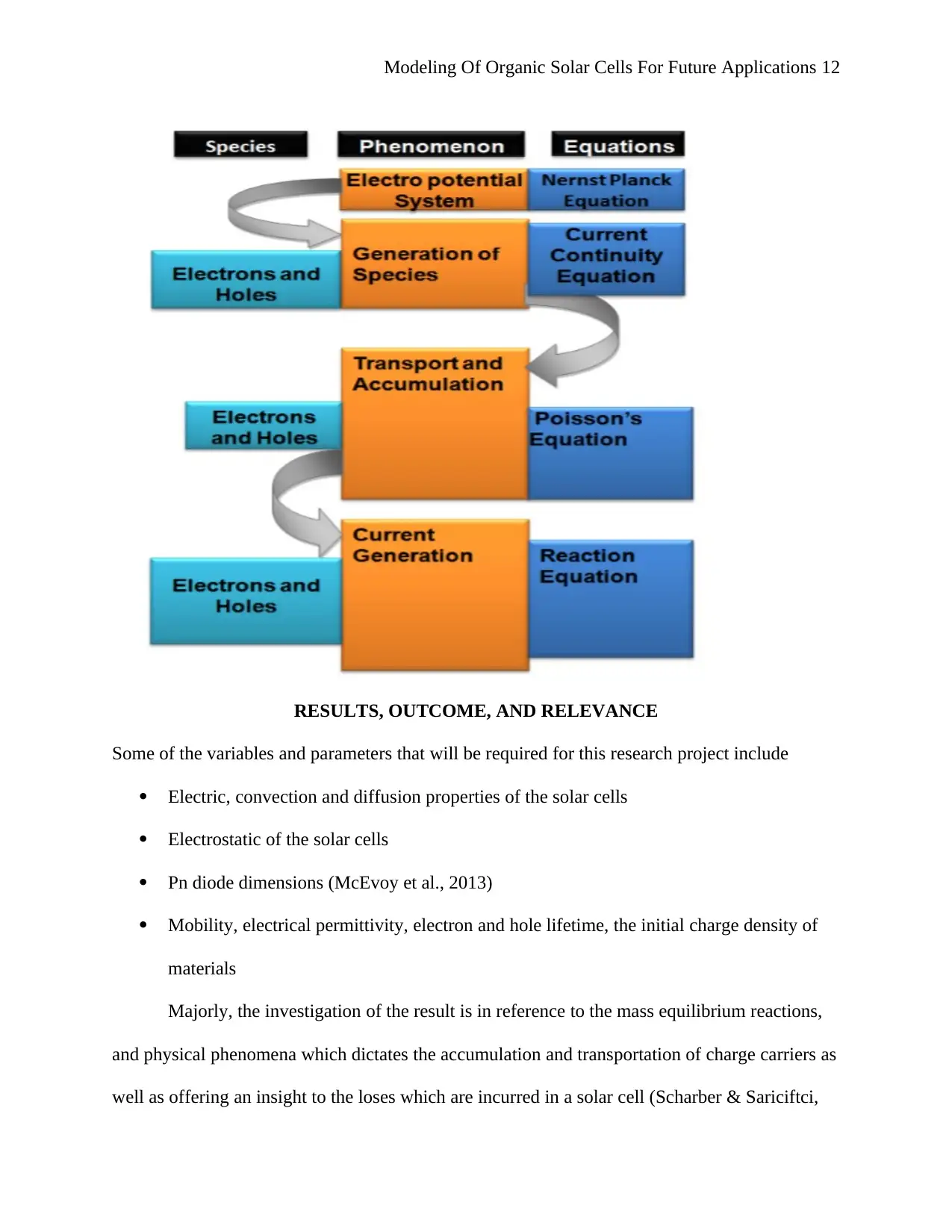
Modeling Of Organic Solar Cells For Future Applications 12
RESULTS, OUTCOME, AND RELEVANCE
Some of the variables and parameters that will be required for this research project include
Electric, convection and diffusion properties of the solar cells
Electrostatic of the solar cells
Pn diode dimensions (McEvoy et al., 2013)
Mobility, electrical permittivity, electron and hole lifetime, the initial charge density of
materials
Majorly, the investigation of the result is in reference to the mass equilibrium reactions,
and physical phenomena which dictates the accumulation and transportation of charge carriers as
well as offering an insight to the loses which are incurred in a solar cell (Scharber & Sariciftci,
RESULTS, OUTCOME, AND RELEVANCE
Some of the variables and parameters that will be required for this research project include
Electric, convection and diffusion properties of the solar cells
Electrostatic of the solar cells
Pn diode dimensions (McEvoy et al., 2013)
Mobility, electrical permittivity, electron and hole lifetime, the initial charge density of
materials
Majorly, the investigation of the result is in reference to the mass equilibrium reactions,
and physical phenomena which dictates the accumulation and transportation of charge carriers as
well as offering an insight to the loses which are incurred in a solar cell (Scharber & Sariciftci,
⊘ This is a preview!⊘
Do you want full access?
Subscribe today to unlock all pages.

Trusted by 1+ million students worldwide
1 out of 16
Related Documents
Your All-in-One AI-Powered Toolkit for Academic Success.
+13062052269
info@desklib.com
Available 24*7 on WhatsApp / Email
![[object Object]](/_next/static/media/star-bottom.7253800d.svg)
Unlock your academic potential
Copyright © 2020–2025 A2Z Services. All Rights Reserved. Developed and managed by ZUCOL.





